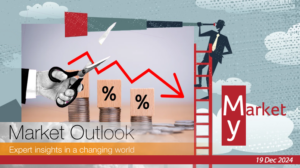It’s difficult not to be amazed by the performance of US stocks that printed another highest level ever (almost touching 3260 last Thursday).
The optimism was primarily driven by market confidence on US signing deal with China on a phase-one deal by mid-January. Even the sour sentiment after US air-strike on the beloved Iranian commander of Quds Force, Soleimani, only managed to drive the stock index lower by a mere 0.7% – meanwhile oil futures and gold soared by 3% and 1.5% respectively on the news, and AUDJPY dropped more than 70 pips as the risk-off proxy in currency space.
Overall the market started the year with some positive sentiment and ended the week with a bit of risk-off tone [S&P500 -1.6%, Oil futures +2.1%, US 10yr rate -4.6bps, Gold +2.7% for the week]. The change of sentiment also disrupted the USD selling against Asian currencies at the start of the year amidst thin liquidity as real-money were rolling their positions. Interestingly, if history is any guide, we don’t think the US stock advance will continue in the month of January 2020. Looking at 1989/90, 1999/00, 2009/2010, the stock index reverses its previous year gain to -7%, -5%, and -4% in January the following year. Hence, what we saw on Friday could be the catalyst needed for some minor corrections.
Nevertheless, we never had such a bubble in the US Treasury before, so any market resemblance has to be taken with a grain of salt. Fundamentally we can’t really expect the stock to have a similar performance as last year. For one, we don’t have the technical rebounds from the drop in December 2018, and secondly, we will face US election which historically synonymous with higher volatility and lower performance in the stock market.
Having said that, we don’t think that the market is too overvalued that it’s going to go over the cliff yet [As shown on the left where the historical the following year returns based on the previous year P/E ratio – Source: Citi research paper].

Therefore, rather than taking a full directional bet on the stock market as a whole, the relative-valuation approach on the cross-sectional sectors is probably a safer play in this space.
Meanwhile, in macro space, we could expect a carry-trade hunt will still continue, and we think Asian EM is still providing robust fundamentals with relatively stable political conditions (which is probably the most important factor among the price driver). Higher tension in the Middle-East due to US air-strike may have negative repercussions impact on high-yielder pairs like INR and IDR – which may actually provide an opportunity to buy in the medium term.
Next week we will undoubtedly see more activity in the market as participants are back from their holidays, and all eyes will be on the upcoming Non-farm Payroll headlines on Friday.




